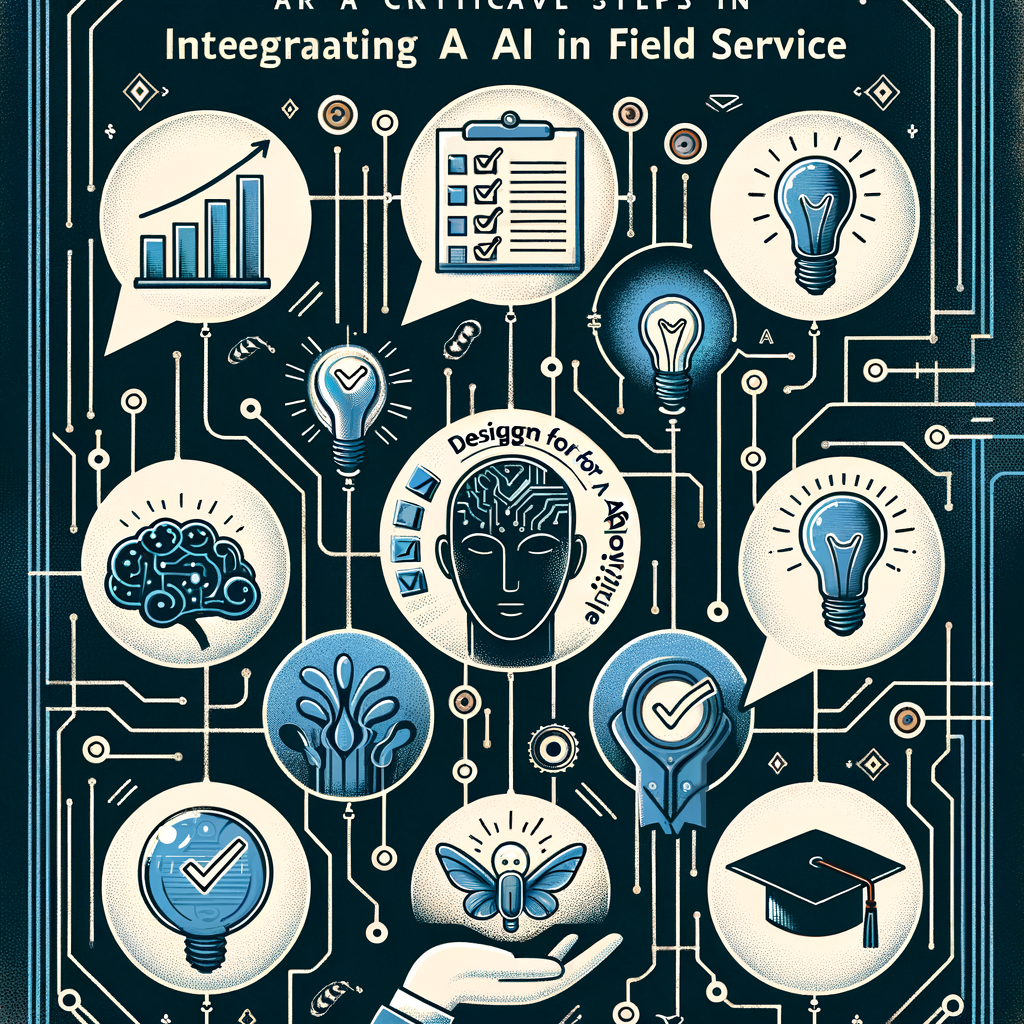The advent of Artificial Intelligence (AI) has not just knocked on our doors; it’s barged in, reshaping the business landscape across various industries. According to the 2024 Microsoft Work Trend Index, a startling 79% of business leaders agree that adopting AI is crucial for staying competitive. Yet, 60% are stumped, lacking a cohesive plan and vision for AI implementation.
When it comes to service organizations, AI stands as a beacon of hope, promising operational efficiencies and enhanced customer satisfaction. However, there’s a chasm between having an AI vision and turning that into reality. Many leaders in the service industry are striving to introduce AI solutions that not only make their workforce—service agents and field technicians included—more productive but also ensure a positive impact on customer interactions. So, how can you transform your AI vision into reality and become AI-ready in field service?

Let’s delve into the five critical steps that will set your organization on the path to AI success.
Step by Step How to Make Your Field Service AI-Ready?
Step 1: Focus on a Framework for Capturing and Proving Business Value
Why Prove Business Value?
Proving business value is often the cornerstone of any successful AI strategy. Your first step is to identify overarching goals for AI adoption, ensuring they align with your business’s top priorities.
How to Do It?
- Identify Specific Goals: Define what you want to achieve. Are you looking to speed up service resolutions, improve customer interactions, or increase your revenue by servicing more customers?
- Align Goals with KPIs: Metrics like resolution rates, customer satisfaction scores, and revenue can serve as your Key Performance Indicators (KPIs). Align these KPIs with your goals to track your progress effectively.
Example Table: Goal Alignment
| Goal | Specific Objective | Key Performance Indicator (KPI) |
|---|---|---|
| Faster Service Resolution | Reduce average resolution time | Resolution time (hours/days) |
| Improved Customer Experience | Increase customer satisfaction | Customer Satisfaction Score (CSAT) |
| Greater Revenue | Service more customers efficiently | Revenue per customer |
This framework will provide a structured approach, ensuring every AI initiative you undertake is directly contributing to your core business goals.
Step 2: Evaluate the Use Cases for AI Applicability
Understand Daily Operations
Once your high-level objectives are clear, take a closer look at daily operations to pinpoint where AI can add the most value.
Identifying Use Cases
- Customer Email Management: Are service agents spending too much time managing customer emails?
- Service History Search: Are they struggling to find customer service histories?
- Scheduling: Could AI-powered automation help in scheduling and filling service gaps?
- Field Technical Support: Do field technicians need better access to service manuals or expert advice for resolving issues promptly?
Quick Wins
By identifying these use cases, you can prioritize quick wins where AI can offer immediate improvements. This provides tangible results, motivating your team to adopt AI more readily.
Step 3: Enable Innovation and Collaboration Early On
Breaking Down Silos : AI can help obliterate information and communication silos, making collaboration and process improvement much smoother.
Streamlined Workflows
- Visibility: Ensure your AI solutions offer clear visibility into workflows.
- Surface Experts: Use AI to identify and connect employees to in-house experts when needed.
- Facilitate Collaboration: Make use of collaborative AI tools to resolve customer issues within the workflow seamlessly.
Step 4: Design for Iteration, Feedback, and Agility
- Agile AI Solutions : Your journey towards AI-readiness isn’t one-size-fits-all; it requires flexibility and ongoing refinement.
- Low-Code Solutions : Empowering your field service teams with AI-powered, low-code solutions lets them quickly develop, test, and iterate new apps and processes.
- Real-time Feedback Loop
- Adapt Quickly: For example, if an automated scheduling process isn’t optimal, you can tweak it based on real-time feedback from field technicians to see immediate benefits.
- Iterative Improvement: Use this feedback loop to continuously refine your AI implementations.
Step 5: Ensure Training and Enablement to Drive Adoption**\n\n**Overcoming Resistance
While resistance to change is common, the latest Microsoft Work Trend Index shows employees are often more ready for AI than their organizations believe.
Training and Enablement
- Choose the Right Provider: Select an AI provider that offers comprehensive training resources.
- Develop Internal Champions: Identify and train internal champions who can help disseminate AI knowledge and spur adoption across the team.
- Continuous Learning: To keep AI solutions from becoming obsolete after the initial excitement fades, ongoing training and enablement are vital. This ensures your employees remain confident and proficient in using AI tools.
Conclusion
Undoubtedly, AI has the potential to revolutionize field service management, driving new levels of productivity and operational efficiency. By focusing on these five essential steps—proving business value, evaluating use cases, fostering innovation, designing for agility, and ensuring robust training—you can transform your AI vision into a tangible reality.
If you’re eager to learn more and dive deeper into how you can implement these steps effectively, consider registering for our upcoming Hitachi Solutions webinar.
Frequen(FAQs)
Q: What are the immediate benefits of implementing AI in field service?
A: AI can automate repetitive tasks, improve scheduling accuracy, and enhance customer satisfaction by reducing resolution times.
Q: How can I ensure my team embraces AI technology?
A: Provide comprehensive training, create internal AI champions, and continuously communicate the benefits of AI to your team.
Q: What metrics should I track to measure AI success in field service?
A: Resolution times, customer satisfaction scores, and revenue per customer are some key metrics to consider.
Q: What are the risks of not adopting AI in field service organizations?
A: The biggest risk is falling behind competitors who leverage AI for improved efficiency and customer satisfaction, leading to potential loss of market share.
By following these steps, your field service organization will not only be AI-ready but also well-positioned to leverage AI for significant business gains. Transform your operations today and lead your industry into the future of AI!
#MSFTAdvocate #AbhishekDhoriya #LearnWithAbhishekDhoriya #DynamixAcademy
References & Read More
- Unlocking the Future: 2024 Release Wave 2 Plans for Microsoft Dynamics 365 and Microsoft Power Platform
- Set Your Power App as the Startup App on Mobile: Unlock Efficiency
- Dynamics 365 Interview Questions and Answers for Experienced and Freshers
- Entity Ownership in Dynamics 365 CRM Interview Questions and Answers
- Unlock the Power of Model-Driven Apps: A Beginner’s Guide to openAlertDialog in Dynamics 365
- Unlocking the Future: How Microsoft’s AI-Powered Tools are Revolutionizing Scientific Discovery


2 thoughts on “Unlocking Success: 5 Essential Steps to Make Your Field Service AI-Ready”